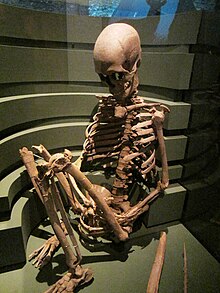Barum Woman
- View a machine-translated version of the Swedish article.
- Machine translation, like DeepL or Google Translate, is a useful starting point for translations, but translators must revise errors as necessary and confirm that the translation is accurate, rather than simply copy-pasting machine-translated text into the English Wikipedia.
- Consider adding a topic to this template: there are already 217 articles in the main category, and specifying
|topic=will aid in categorization. - Do not translate text that appears unreliable or low-quality. If possible, verify the text with references provided in the foreign-language article.
- You must provide copyright attribution in the edit summary accompanying your translation by providing an interlanguage link to the source of your translation. A model attribution edit summary is
Content in this edit is translated from the existing Swedish Wikipedia article at [[:sv:Barumskvinnan]]; see its history for attribution. - You may also add the template
{{Translated|sv|Barumskvinnan}}to the talk page. - For more guidance, see Wikipedia:Translation.
Barum Woman | |
|---|---|
 Barum Woman's skeleton in 2012 | |
| Died | 7010 – 6540 BCE now Skane, Sweden |
| Body discovered | 27 May 1939 by Sven Eriksson |
| Resting place | Stockholm, Stockholm County, Sweden |
Barum Woman (died 7010–6540 BCE, also known as Bäckaskogskvinna) was a Mesolithic woman whose skeleton was found in 1939 in Barum [sv], Sweden and is now in the Swedish History Museum in Stockholm.[1][2][3][4]
Her skeleton was found in 1939 on the shore of Oppmannasjön [sv] lake at Barum [sv] village, near Bäckaskog in the county of Skane, and on the property of Bäckaskog Castle. She was believed to be male, and was called The Fisher from Barum because flint arrows believed to be used for fishing were found in the grave. When it was established in the 1970s that she was female, she was renamed Bäckaskogskvinna (Bäckaskog woman), and in 2016 the museum renamed her as Kvinnan från Barum (The woman from Barum) to reflect local wishes in Scania province, and in line with a 2015 book published with the title Kvinnan från Barum - från äldre stenåldern ("The woman from Barum - from the older Stone Age") by Björn Wallebom, an archaeologist at the museum.[5] In English-language sources the terms "Barum woman" and "Woman from Barum" are both used.
She was found in 1939 by farmers digging for gravel, who removed her skull and some other bones. A professional archaeologist Folke Hansen then excavated the rest of the skeleton, made a drawing and took three photographs, and wrote up his findings.[1] She has been exhibited in the Swedish History Museum since 1943[5] and is regarded as one of the highlights of its prehistory collection.[4]
In 1970, Gjevall re-examined the skeleton and declared it to be female, with the pelvis showing signs of childbirth.[6] In 1996, the skeleton underwent more investigation with a view to its conservation, and this was described in a paper in Fornvännen in 2000. Sten et al wrote that an analysis of her bones had given a height 151 centimetres (4 ft 11 in) and age at death of 40-45 years, while an assessment of her teeth had indicated an age at death of 32–40 years. Her diet had been mainly vegetables, and her burial took place in the spring (from pollen analysis) in the period 7010–6540 BCE.[6]
References
- ^ a b Sten, Sabine; Welinder, Stig (2007). "The eternal traveller from Barum". In Jennbert, Kristina; Hårdh, Birgitta; Olausson, Deborah (eds.). On the Road : Studies in Honour of Lars Larsson. (Acta Archaeologica Lundensia. Series in 4°; Vol. 26) (PDF). Almqvist & Wiksell International. pp. 151–156.
- ^ Bojs, Karin (22 May 2018). "Dark Skin, Blue Eyes". My European Family: The First 54,000 Years. Bloomsbury USA. pp. 110–118. ISBN 978-1-4729-4145-9.
- ^ "9000 year old skeleton: The Bäckaskog woman". Kringla. Retrieved 1 May 2022.
- ^ a b "Prehistories". historiska.se. The Swedish History Museum. Retrieved 1 May 2022.
- ^ a b "Sveriges mest kända stenålderskvinna byter namn". Historika museet (in Swedish). 26 April 2016. Retrieved 1 May 2022.
- ^ a b Sten, Sabine; et al. (2000). "Barumkvinnan. Nya forskningsrön" (PDF). Fornvännen. 95: 73–87. In Swedish with English summary on page 87
Further reading
- Wallebom, Björn (2015). Kvinnan från Barum - från äldre stenåldern : en forskningshistorik samt därtill några ställningstaganden och tillrättalägganden, kritiska anmärkningar och slutsatser (in Swedish). Stockholm: Historiska museet. ISBN 9789189176621.
- Hansen, Folke (1941). "Fiskaren från Barum – från äldre stenåldern". Handling- ar angående Villands härad utgivna av Villands härads hembygdsförening. 3: 13–19. First description of the skeleton









